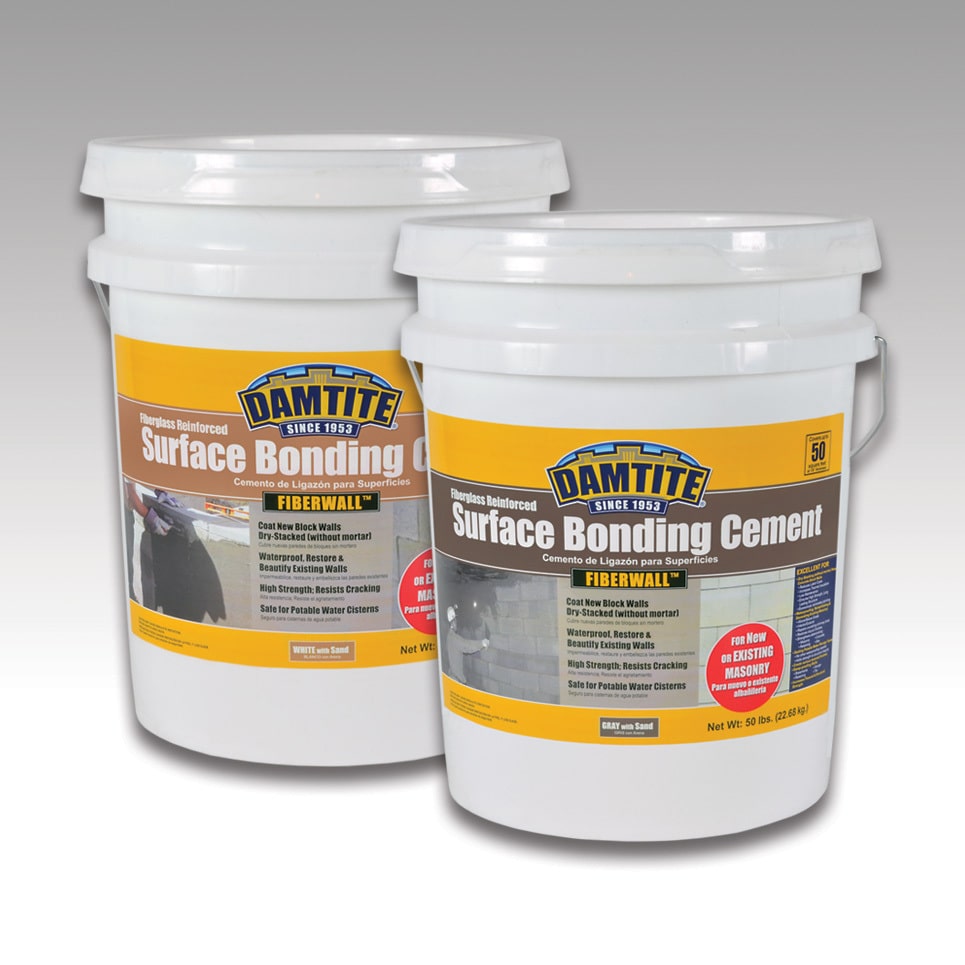Fiberglass Reinforced
FiberWall Surface Bonding Cement
White & Gray with Sand
- Coat New Block Walls Dry-Stacked (without mortar)
- Waterproof, Restore & Beautify Existing Walls
- High Strength; Resists Cracking
- Safe for Potable Water Cisterns
- For New or Existing Masonry
FIBERWALL™ is an alkali-resistant, fiberglass-reinforced, Portland cement-base Surface Bonding Cement with sand, used for construction of concrete block walls by dry-stack (without mortar). It is also ideal to waterproof, strengthen, rehabilitate, reinforce, restore, and beautify various existing deteriorating surfaces, including chimneys, retaining walls and other concrete, brick, stone, tile or stucco areas above & below grade, on the interior & exterior.
For Application over Existing Surfaces: Ensure surface is sound, remove any loose particles and thoroughly clean any oil, grease, forming compounds from the surface since they would inhibit good adhesion of the coating onto the surface. It is important to also neutralize any efflorescence (white, salt deposit of alkali), mold or mildew on the surface with Damtite Concrete Cleaner Crystals mixed with clean water (safe and odorless in non-ventilated areas) or with Muriatic Acid, following instructions on the label. Then, repair all cracks and holes in the surface with Damtite Hydraulic Cement. Pre-wet surface completely with clean water prior to and during application of FIBERWALL.
For Application on New Construction of Dry-Stacked Concrete Blocks: As noted above, ensure surface is clean. Use quality materials and accepted construction techniques. Footers should be sound and level. Set the first course of block into mortar. Do not strike the joints. Allow mortar to set approximately 4-8 hours before stacking remaining courses of block in a running bond pattern. Fit blocks snugly and remove any burrs or appendages to ensure good tight fit between blocks. Check every third course of block for plumb and straightness.
For application over Bare, Porous Surfaces (new concrete block): To a clean mixing container, first add 2 gallons (7.5 L) of clean water. Remove the package of fiberglass strands from inside of the FIBERWALL pail. Slowly add 50 lb (22.68 Kg) of FIBERWALL Cement to the liquid, constantly mixing and stirring to “pancake” consistency. Next, pour the fiberglass strands from the package into the mix and stir well again to ensure the strands are dispersed. If using a mechanical mixer, keep mixing time to a minimum to avoid damaging fibers. Apply within 30-minutes before mix starts to harden. If mix hardens sooner, due to warm temperature, add a small amount of water to retemper the mix. If mix becomes too thick or difficult to trowel onto surface, prepare a fresh mix.
For Application on New Construction of Dry-Stacked Concrete Blocks: As noted above, ensure surface is clean. Use quality materials and accepted construction techniques. Footers should be sound and level. Set the first course of block into mortar. Do not strike the joints. Allow mortar to set approximately 4-8 hours before stacking remaining courses of block in a running bond pattern. Fit blocks snugly and remove any burrs or appendages to ensure good tight fit between blocks. Check every third course of block for plumb and straightness.
Mix can be applied with plasterer’s trowel, masonry brush, or suitable textured spray equipment. Ensure surface is pre-wetted with clean water prior to coating to avoid moisture being withdrawn from the mixture while curing. Apply mixture generously to open joints and to any cracks. Cover the surface with a coating of 1/8 inch (3.2 mm) minimum thickness. For dry-stack construction: apply mixture to both sides of concrete block walls. With plasterer’s hand tools, an attractive textured finish can be achieved, from smooth to very deep relief stucco look. Can also provide simulated brick wall or exposed aggregate concrete finishes. If second coat is required, allow first coat to dry for 24-48 hours, depending upon ambient temperature, humidity, and ventilation. Ensure dry to touch before applying second coat. Again, pre-wet surface and follow instructions above.
Depending upon surface porosity, coverage will vary. Average coverage, at 1/8 inch (3.2 mm) thickness, is 50 square foot (4.6 square meter) per each 50lb (22.68 Kg) pail.

